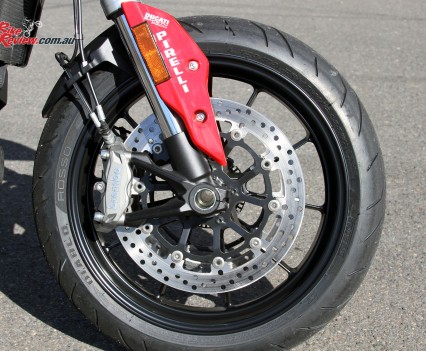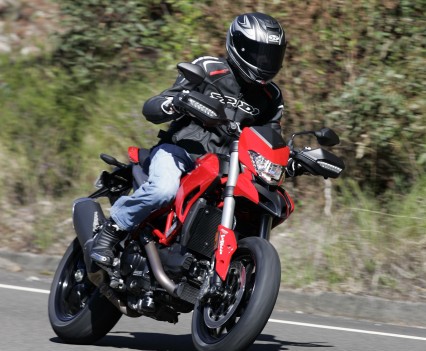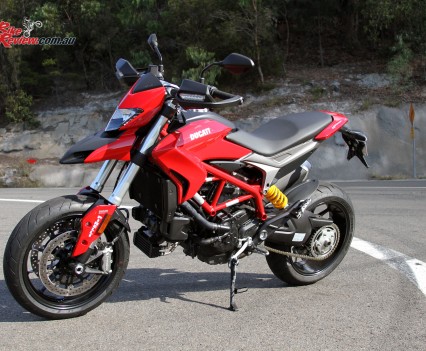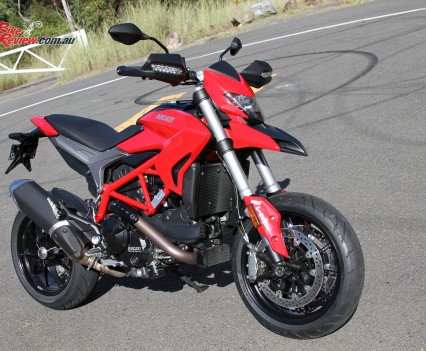Review: 2016 Ducati Hypermotard 939
Ducati's Hypermotard 939 is a unique offering with plentiful torque and great agility - the ultimate hoon machine. Here's our full review. Test by Kris Hodgson, Photography by Kris, David Hodgson
On face value the Hypermotard 939 was described to me as more refined than the previous version and the move to a larger capacity was necessary due to strict Euro4 emission restrictions which meant less power if retaining the previous 821 engine.
The 2016 939 has received a capacity boost, with a slight increase in peak power and 10 per cent more peak torque, with an additional 18 per cent more in the mid-range, to ensure there was more drive and fun from down low, where you’re often stuck spending much of your time on the road.
 Styling is always subjective but the Ducati Hypermotard is a very cool machine in my opinion and I’ve thought so since first seeing one in the movie Yes Man – you can look up the scene on YouTube if you don’t know what I’m talking about. The bike is tall but the aggressive front end, minimalist styling and bullish presence give it a muscle-bike feel, to me at least.
Styling is always subjective but the Ducati Hypermotard is a very cool machine in my opinion and I’ve thought so since first seeing one in the movie Yes Man – you can look up the scene on YouTube if you don’t know what I’m talking about. The bike is tall but the aggressive front end, minimalist styling and bullish presence give it a muscle-bike feel, to me at least.
It’s also relatively simple, for a Ducati, with three Modes – Urban, Sport and Touring, plus preset ABS and DTC settings in each Mode as standard. The display is simple and clear, although the textured screen can make it hard to read if the sun is on it, while ‘bar guards and rubber clad ‘pegs lend the bike a dirtbike-motard-like theme.
The Hypermotard 939 is powered by a liquid-cooled 937cc Testastretta Desmodromic 11° L-Twin, which retains the previous model’s stroke but has a larger bore of 94mm, with all new pistons, cylinders and cylinder-heads. The previous model’s 52mm throttle-bodies and Ride-by-wire system has been retained with power now up to 113hp, and 97.9Nm of torque.
 A mechanical assist/slipper clutch helps reduce the effort needed on the clutch lever while increasing stability on engine braking into turns. The exhaust is also a new system, now with 50mm diameter headers and an all new muffler that does a great job of lowering the bike’s volume. That being said, onboard it sounds pretty loud, but having photos taken our photographer was quick to point out he had trouble knowing when we’d be coming past, the bike’s that quiet!
A mechanical assist/slipper clutch helps reduce the effort needed on the clutch lever while increasing stability on engine braking into turns. The exhaust is also a new system, now with 50mm diameter headers and an all new muffler that does a great job of lowering the bike’s volume. That being said, onboard it sounds pretty loud, but having photos taken our photographer was quick to point out he had trouble knowing when we’d be coming past, the bike’s that quiet!
Power output is also controlled by the three engine Modes. I found Touring quite disappointing, there was a strange surging/hunting through much of the midrange when you’re holding the throttle steady, almost as though the bike was taking up slack in the drive train, dropping it off and then picking it up again. The Panigale 1199 had the same problem on constant throttle but not the 1299.
Switching to Urban and Sport modes made this almost unnoticeable, with Urban mode offering a more linear and controlled feel through the throttle but acceleration feeling a little less blistering as you rev’d the bike harder through the mid-range. Sport on the other hand was a bit more instantaneous, although I did notice the initial throttle opening was very very soft, with quite a bit of throttle required to get the bike moving.
 I also noticed that at a standstill at lights the bike would hunt at idle, which I initially thought was me rolling the throttle on imperceptibly, but after keeping my hands off it entirely could still hear the bike’s revs changing, even though the RPM indicator on the dash wasn’t moving.
I also noticed that at a standstill at lights the bike would hunt at idle, which I initially thought was me rolling the throttle on imperceptibly, but after keeping my hands off it entirely could still hear the bike’s revs changing, even though the RPM indicator on the dash wasn’t moving.
That said, Urban and Sport modes offered the best rideability in the traffic, with my preference being Urban. You also don’t want to be lugging the engine, as combustion is a bit rough at extremely low speeds, something which doesn’t totally smooth out till after 6000rpm, and with the tall gearing you’ll be feathering the clutch a fair bit if you’re caught in traffic. With the relaxed, tall and upright position it is extremely easy to simply roll along with minimal engine input in these situations though.
Thinking about what defines the bike it’s definitely the engine which really demands a more hoonish approach to riding, it’s great fun smashing through the gears and using the bike’s agility to carve through traffic, up the hills or your locals, and in regular traffic or on more open roads there’s good fun to be had by pushing the bike further into the rev range and generally behaving like a teenager!
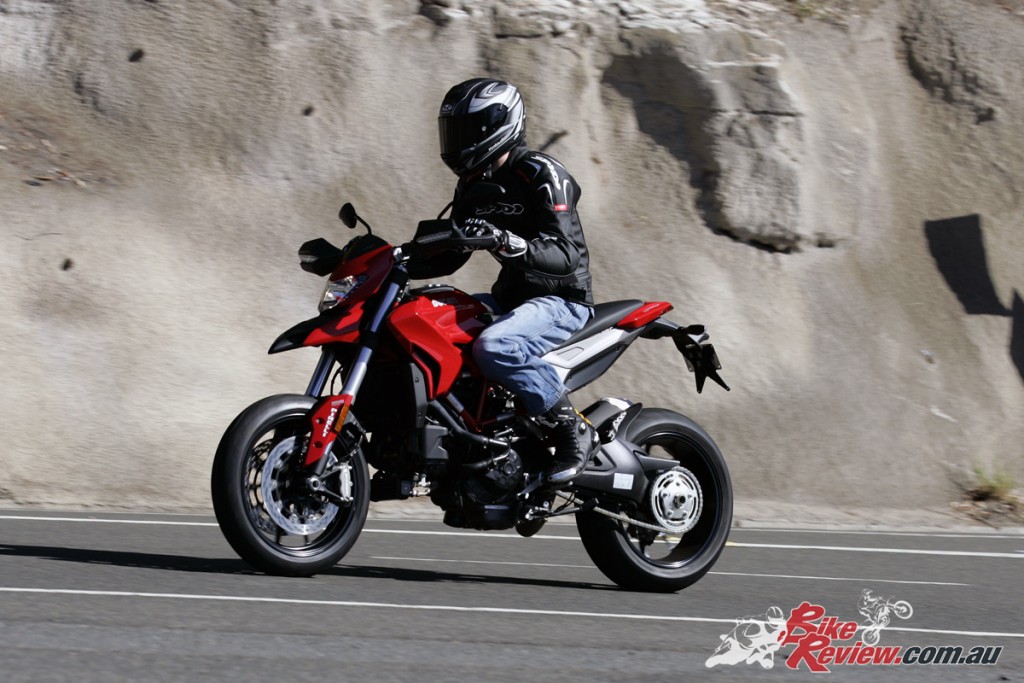 It’s going to be a polarising feature however, especially for those who aren’t willing to accept the bike’s rougher performance in some conditions as a trade-off for the fun you can have when you’re hooning around and riding aggressively. There’s a trade-off with all bikes of course, it’s just in some cases you weren’t after the feature that’s being traded off, making it a non-issue!
It’s going to be a polarising feature however, especially for those who aren’t willing to accept the bike’s rougher performance in some conditions as a trade-off for the fun you can have when you’re hooning around and riding aggressively. There’s a trade-off with all bikes of course, it’s just in some cases you weren’t after the feature that’s being traded off, making it a non-issue!
The electronics are also great, with the Modes offering preset settings, the traction control getting a good workout thanks to a few dirt and slippery tar sections around where we did our shoot. It’s a good safety net, especially on a motorcycle that encourages aggressive riding habits. The ABS is also a two level system with low and high intervention, with low offering limited lift-up control. Plus for those who don’t like being stuck with a self-activating ABS, it can be deactivated and saved via the instrumentation, individually for each mode.
 The non-adjustable Marzocchi forks and adjustable Sachs rear shock offer a smooth ride and the bike performed faultlessly aside from the odd bit of instability from the rear over road irregularities. The front end feel was a little vague through the twisties but the bike was doing exactly as I wanted and I could push as hard as I liked, it just felt a bit disconnected.
The non-adjustable Marzocchi forks and adjustable Sachs rear shock offer a smooth ride and the bike performed faultlessly aside from the odd bit of instability from the rear over road irregularities. The front end feel was a little vague through the twisties but the bike was doing exactly as I wanted and I could push as hard as I liked, it just felt a bit disconnected.
That’s something I have noticed with non-adjustable Marzocchi forks in the past however, they tend to provide a softer ride, which is great for comfort over regular roads. The bike was super stable however and could turn on a hairpin, with easy U-turns. The rear is a Sachs unit with preload adjustability, and rebound adjustability. The front could do with more support for heavy braking.
The brakes are Brembo items and with plenty of fast aggressive acceleration the bike’s modus operandi, you really want plenty of performance there to match all the go on hand. Sure 113hp isn’t earth shattering but there’s plenty of torque and the bike performs best hard on the throttle.
 I found it was a bit of a stretch to the front brake lever but actually ended up adjusting it out one turn, simply because it massively firmed up the lever action, giving better initial bite. The brakes are powerful though and being too aggressive can unsettle the bike due as mentioned to the soft forks causing the bike to pitch forward, which is a tune used for super motard to get the back around but not what you would need every day on the 939.
I found it was a bit of a stretch to the front brake lever but actually ended up adjusting it out one turn, simply because it massively firmed up the lever action, giving better initial bite. The brakes are powerful though and being too aggressive can unsettle the bike due as mentioned to the soft forks causing the bike to pitch forward, which is a tune used for super motard to get the back around but not what you would need every day on the 939.
As mentioned the upright position offers a broad reach to the ‘bars and I actually noticed after a few days of riding the bike I was feeling it across the top of my shoulders. The seating position is relatively neutral and I had real trouble finding a comfortable area to grasp with my knees when the going got faster. I did find however that the bike’s tall seat height meant I needed to reposition after leaving a stop, as I would have shifted to get one foot flat to the ground. Doing this helped comfort a lot.
 The hand guards offer good protection from the elements and also incorporate highly visible indicators, the only downside is the bike’s relatively wide at the ‘bars and there was lots of situations I wasn’t able to filter, where I normally would. The mirrors were also really stylish, but have one corner cut out to look cool, which is where I always wanted to see, frustrating me. The seating position does make shoulder checks incredibly easy however.
The hand guards offer good protection from the elements and also incorporate highly visible indicators, the only downside is the bike’s relatively wide at the ‘bars and there was lots of situations I wasn’t able to filter, where I normally would. The mirrors were also really stylish, but have one corner cut out to look cool, which is where I always wanted to see, frustrating me. The seating position does make shoulder checks incredibly easy however.
Wind on a nakedbike will also always be noticeable but at regular (legal) road speeds I didn’t find it an issue, even on the freeway. After a couple of hours it’d probably become an annoyance but at normal speeds it wasn’t a concern. As a naked though once you get past a certain point the wind does become a major consideration.
Overall Ducati’s Hypermotard 939 is a very different machine and one which I became more comfortable with the more time I spent on the bike. It’s really a machine that would be hard to test ride in a short period unless you’re jumping off something really similar in my opinion.
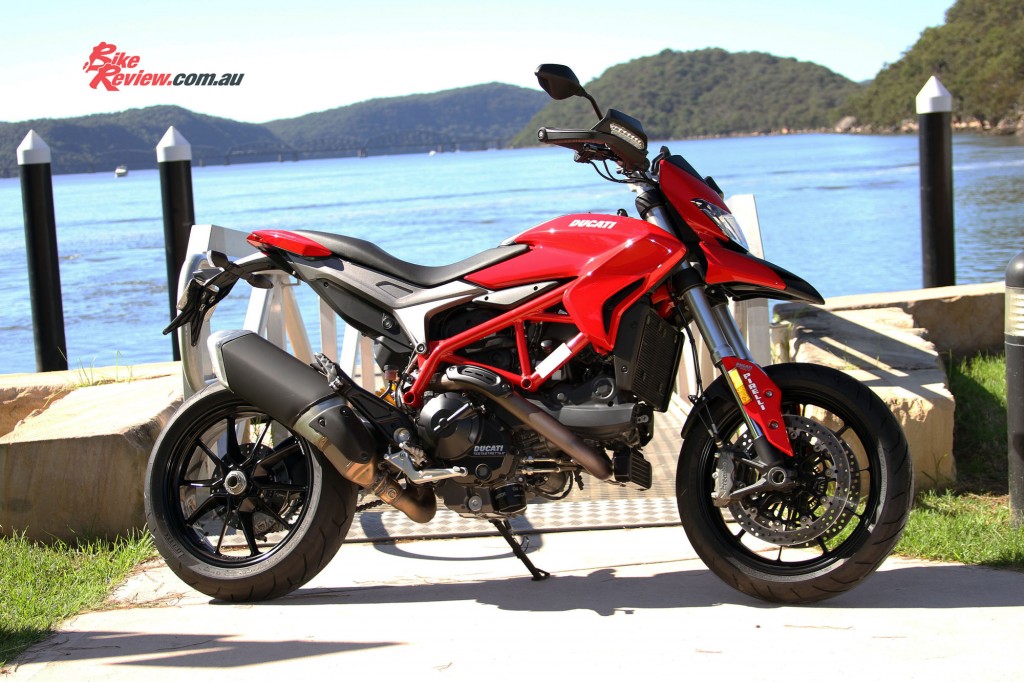 It’s got typical Ducati styling, which is great, with equally good production quality, something you can trust Ducati to deliver. It’s also a true Ducati in that they’ve gone their own way and created something unique. There’s plenty of jokes about ‘character’ and I’ll be the first to say I think this bike has character. Now whether you like or want character is a personal thing.
It’s got typical Ducati styling, which is great, with equally good production quality, something you can trust Ducati to deliver. It’s also a true Ducati in that they’ve gone their own way and created something unique. There’s plenty of jokes about ‘character’ and I’ll be the first to say I think this bike has character. Now whether you like or want character is a personal thing.
 It’s also packed with technology, which ensures good safety, and is a machine I could use as a daily ride. It wouldn’t be my first choice with the traffic I face, but it is capable and you’ll need to keep in mind this is the base version. The SP offers fully adjustable Ohlins suspension both front and rear in comparison.
It’s also packed with technology, which ensures good safety, and is a machine I could use as a daily ride. It wouldn’t be my first choice with the traffic I face, but it is capable and you’ll need to keep in mind this is the base version. The SP offers fully adjustable Ohlins suspension both front and rear in comparison.
There were times I’ll admit to being a bit exasperated at the character this bike offers, but testing the Hypermotard 939 for a week was a positive experience and I look forward to seeing how the SP compares.
 2016 Ducati Hypermotard 939 Engine
2016 Ducati Hypermotard 939 Engine
The Hypermotard 939 twin-cylinder Ducati Testastretta 11° engine has an increased displacement due to the bore being raised from 88 to 94mm. The stroke remains 67.5mm. The crankshaft is new with a 42mm diameter crank pin. There new pistons, cylinders and cylinder heads with an exclusive core to allow water through. The EURO 4 certified engine produces 113hp at 9,000rpm and a maximum torque of 97.9Nm at 7,500rpm, which is much greater than the previous engine.
Compression ratio has also increased, now 13.1:1, while the 52 mm diameter throttle bodies, and full Ride-by-Wire system, are unchanged. The engine is equipped with an oil-bath clutch with slipper function that can be engaged with reduced effort on the lever. The self-servo system also intervenes when the wheel torque displays counter action and allows the vehicle to maintain stability during the aggressive gear changes.
The two-in-one exhaust has completely redesigned 50mm diameter tubes and exhaust valve, which lead to the new, highly compact mono-silencer with absorption technology. The 937 cm3 Ducati Testastretta 11° has maintenance intervals of 30,000 km (18,000 miles).
 2016 Ducati Hypermotard 939 Chassis
2016 Ducati Hypermotard 939 Chassis
The Hypermotard 939 has a 34 mm diameter tubular steel Trellis frame with 25.5° of rake, and trail and offset of 104mm and 30mm respectively. The frame marries to a die-cast sub-frame and incorporates a techno-polymer mid-section as part of the assembly. The swingarm is a single-sided aluminium item.
The Hypermotard has a highly manoeuvrable 70° of lock-to-lock steering movement, and an optimised wheelbase to enhance high-speed stability. Seat height is 870mm.
Forks are 43mm USD Marzocchi items, without adjustment, while the rear shock is a Sachs unit with preload and rebound adjustment. Wheels are 10-spoke light alloy 17in items and clad in Pirelli Diablo Rosso II tyres as standard, with Brembo brakes front and rear. Dual 320mm semi-floating front rotors are mated to radial Brembo Monobloc four-piston calipers, while a single two-piston caliper on the rear is joined by a 245mm rotor.
 2016 Ducati Hypermotard 939 Electronics
2016 Ducati Hypermotard 939 Electronics
The Testastretta 11° continues to use the last generations 52mm throttle-body, with RbW and a Magneti Marelli EFI system. Ducati Traction Control comes standard with eight levels of adjustment.
Three ride modes, Touring, Urban and Sport offer preset DTC and ABS settings, with ABS able to be switched off permanently. Riding modes also control power output and throttle response.
ABS is a Bosch unit, with two levels, offering more and less intervention, and the display is an LCD multifunction system, controlled from the left switchblock.
2016 Ducati Hypermotard 939 Specifications
Price: $17,790 + ORC
Warranty: Two-year, unlimited kilometre
Colours: Ducati Red, Star White Silk
Claimed power: 83.1kW[113hp]@9000rpm
Claimed torque: 97.0Nm[72.2ft-lbs]@7500rpm
Dry weight: 181kg
Fuel capacity: 16L
Engine: Liquid-cooled, Testastretta 11° L-Twin, four-valve per cylinder, Desmodromic, 937cc, 94 x 67.5mm bore x stroke, 13.1:1 compression, Magneti Marreli EFI, RbW, DTC, Ride Modes, two-into-one exhaust, single stainless steel muffler
Gearbox: Six-speed
Clutch: Wet multiplate clutch, mechanical self-servo/slipper
Chassis: Tubular steel Trellis frame, die-cast sub-frame, techno-polymer mid-section , aluminium single-sided swingarm Rake: 25.5°, Trail: 104mm
Suspension: Marzocchi 43mm USD forks, non-adjustable, Sachs monoshock, preload and rebound adjustable
Brakes: Bosch switchable ABS, dual 320mm semi-floating front rotors, Brembo radial Monobloc four-piston calipers, single 245mm rear rotor, twin-piston caliper
Wheels & Tyres: Light alloy 10-spoke, 3.50 x 17in, 5.50 x 17in, 120/70 – 17in, 180/55 – 17in, Pirelli Diablo Rosso II
Dimensions:
Wheelbase: 1493mm
Seat height: 870mm
Overall height: 1155mm
Overall width: 895mm
Instruments: LCD multifunction display, Dot Matrix area
2016 Ducati Hypermotard 939 Gallery
The Verdict | Review: 2016 Ducati Hypermotard 939
Hoon!
An agile, torquey hoon machine!





